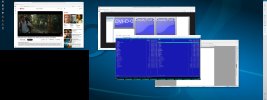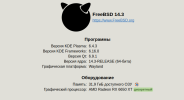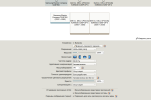Good morning!
I bought a vintage 32" DELL UP3214Q monitor Amd Radeon R9 285 Video supports version 1.2The system has two monitors 24" - 1920x1080_60Hz and 32" - 3840x2160_30Hz or _60Hz if the monitor is connected via DisplayPort ver. 1.2 The 32" monitor can be switched to normal DP1.0 or DP1 mode.2. In DP1.2 mode, the 32" monitor can be set to 3840x2160_60Hz. It works fine in Windows. But not in FreeBSD 14.2.
Set DP1.0: normally, there are two monitors in maximum modes. The system defines two DVI-D-0 and DisplayPort-0 inputs.
Set DP1.2 :
And my system normal work if M32" set to DP1.0 for exept 60Hz only 30Hz . This small truble is nervus
. This small truble is nervus  .
.
I changed xorg.conf in different ways until I settled on the configuration of xorg.conf attached in the attachment. The image file and the current monitor configuration are also attached there.FreeBSD believes that the M32 is two monitors each at 1920x2160 and indeed they "work together" as one at 3840x2160 and 60Hz.DE Lxde and Openbox start normally, as does sddm. KDE - plasmashell is not displayed.Software: Drivers (all needed) and any drm/mesa have been installed and updated to the latest version as of the date of publication of this post. Any needent options added to rc.conf, loader.conf and other places.
If you have any ideas on how to normalize with the plasma situation or, if possible, bring it to the "two monitors" state.
Thanks for any ideas.
I bought a vintage 32" DELL UP3214Q monitor Amd Radeon R9 285 Video supports version 1.2The system has two monitors 24" - 1920x1080_60Hz and 32" - 3840x2160_30Hz or _60Hz if the monitor is connected via DisplayPort ver. 1.2 The 32" monitor can be switched to normal DP1.0 or DP1 mode.2. In DP1.2 mode, the 32" monitor can be set to 3840x2160_60Hz. It works fine in Windows. But not in FreeBSD 14.2.
Code:
# pciconf -lcv
...
vgapci0@pci0:11:0:0: class=0x030000 rev=0x00 hdr=0x00 vendor=0x1002 device=0x6939 subvendor=0x1043 subdevice=0x0486
vendor = 'Advanced Micro Devices, Inc. [AMD/ATI]'
device = 'Tonga PRO [Radeon R9 285/380]'
class = display
subclass = VGA
cap 09[48] = vendor (length 8)
cap 01[50] = powerspec 3 supports D0 D1 D2 D3 current D0
cap 10[58] = PCI-Express 2 legacy endpoint max data 256(256) RO NS
max read 512
link x16(x16) speed 2.5(8.0) ASPM L1(L0s/L1)
cap 05[a0] = MSI supports 1 message, 64 bit enabled with 1 message
ecap 000b[100] = Vendor [1] ID 0001 Rev 1 Length 16
ecap 0001[150] = AER 2 0 fatal 1 non-fatal 1 corrected
ecap 0015[200] = Resizable BAR 1
ecap 0019[270] = PCIe Sec 1 lane errors 0xfffe
ecap 000f[2b0] = ATS 1
ecap 0013[2c0] = Page Page Request 1
ecap 001b[2d0] = Process Address Space ID 1
ecap 000e[328] = ARI 1Set DP1.0: normally, there are two monitors in maximum modes. The system defines two DVI-D-0 and DisplayPort-0 inputs.
Code:
# xrandr -q
Screen 0: minimum 320 x 200, current 5760 x 2160, maximum 16384 x 16384
DVI-D-0 connected primary 1920x1080+0+0 (normal left inverted right x axis y axis) 521mm x 293mm
1920x1080 60.00*+ 71.91 50.00 59.94
1680x1050 59.88
1600x900 60.00
1280x1024 60.02
1440x900 59.90
1280x800 59.91
1280x720 60.00 50.00 59.94
1024x768 70.07 60.00
800x600 72.19 60.32 56.25
720x576 50.00
720x480 60.00 59.94
640x480 72.81 66.67 60.00 59.94
720x400 70.08
DisplayPort-0 connected 3840x2160+1920+0 (normal left inverted right x axis y axis) 698mm x 392mm
3840x2160 30.00*+
1920x1200 59.88
1920x1080 60.00
1600x1200 60.00
1680x1050 59.95
1280x1024 75.02 60.02
1280x800 59.81
1152x864 75.00
1024x768 75.03 60.00
800x600 75.00 60.32
640x480 75.00 59.94
720x400 70.08
DisplayPort-1 disconnected (normal left inverted right x axis y axis)
DisplayPort-2 disconnected (normal left inverted right x axis y axis)
HDMI-A-0 disconnected (normal left inverted right x axis y axis)Set DP1.2 :
Code:
# xrandr -q
Screen 0: minimum 320 x 200, current 5760 x 2160, maximum 16384 x 16384
DisplayPort-0 disconnected (normal left inverted right x axis y axis)
HDMI-A-0 disconnected (normal left inverted right x axis y axis)
DVI-D-0 connected primary 1920x1080+0+0 (normal left inverted right x axis y axis) 521mm x 293mm
1920x1080 60.00*+ 71.91 50.00 59.94
1680x1050 59.88
1600x900 60.00
1280x1024 60.02
1440x900 59.90
1280x800 59.91
1280x720 60.00 50.00 59.94
1024x768 70.07 60.00
800x600 72.19 60.32 56.25
720x576 50.00
720x480 60.00 59.94
640x480 72.81 66.67 60.00 59.94
720x400 70.08
DVI-D-1 disconnected (normal left inverted right x axis y axis)
DisplayPort-1 connected 1920x2160+3840+0 (normal left inverted right x axis y axis) 698mm x 392mm
1920x2160 59.99*+
1920x1080 59.99
DisplayPort-2 connected 1920x2160+1920+0 (normal left inverted right x axis y axis) 698mm x 392mm
1920x2160 59.99*+
1920x1200 59.88
1920x1080 60.00
1600x1200 60.00
1680x1050 59.95
1280x1024 75.02 60.02
1280x800 59.81
1152x864 75.00
1024x768 75.03 60.00
800x600 75.00 60.32
640x480 75.00 59.94
720x400 70.08And my system normal work if M32" set to DP1.0 for exept 60Hz only 30Hz
I changed xorg.conf in different ways until I settled on the configuration of xorg.conf attached in the attachment. The image file and the current monitor configuration are also attached there.FreeBSD believes that the M32 is two monitors each at 1920x2160 and indeed they "work together" as one at 3840x2160 and 60Hz.DE Lxde and Openbox start normally, as does sddm. KDE - plasmashell is not displayed.Software: Drivers (all needed) and any drm/mesa have been installed and updated to the latest version as of the date of publication of this post. Any needent options added to rc.conf, loader.conf and other places.
If you have any ideas on how to normalize with the plasma situation or, if possible, bring it to the "two monitors" state.
Thanks for any ideas.
Attachments
Last edited:





